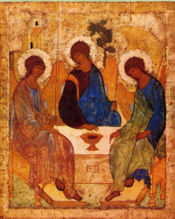Holy Trinity
| This article forms part of the series Introduction to Orthodox Christianity | |
| Holy Tradition | |
| Holy Scripture The Symbol of Faith Ecumenical Councils Church Fathers Liturgy Canons Icons | |
| The Holy Trinity | |
| God the Father Jesus Christ The Holy Spirit | |
| The Church | |
| Ecclesiology History Holy Mysteries Church Life | |
| Edit this box | |
The term Trinity dates back at least to the time of Tertullian. It combines the concepts of tri- (three) and unity (one), and refers to the three Persons of God who are consubstantial (i.e. of one essence or homoousios) and coeternal with each other. There never was a time when any of the Persons of the Trinity did not exist, for God is beyond and before time--though He acts within time, both moving and speaking within history thereby revealing Himself.
Explanation of the Trinity
WHAT GOD IS NOT: God is not an impersonal essence nor merely a "higher power." Neither are God and Trinity simply singular names for what would otherwise be considered three gods (i.e. terms which would hide polytheism).
WHAT GOD IS: Though the Trinity is a mystery beyond comprehension, two analogies are often used to help explain what Trinity means. The first references the sun, and the second references man.
The Sun: The sun is characterized by three elements. (1) The ball of burning gas is the source of all (like the Father). (2) The light is visible to all (like the Son). (3) The heat is felt, but not seen (like the Holy Spirit or Comforter).
The sun has never been the sun without its light and heat, and the light and heat cannot exist without their source. In addition, while they may co-exist, they do not produce each other in and of themselves. (ex. You can’t read by the light of a heating pad, nor can you count on getting warm wherever it is bright.)
Man: It is said that each human has been made in the image of God, and as such each human bears similarities to our Trinitarian Lord and God: (1) Man's nous (i.e. complete mind and heart; including intellect, creativity, feelings, morality, intuition, etc.) is like the Father. (2) Man's flesh (both tangible and a temple of the Holy Spirit), is akin to the Son who became incarnate and was filled with the Holy Spirit. (3) Man's life (or breath) is akin the Holy Spirit.
Man (any human) is all three. There is never a time that man has existed (or could exist) without all three. For a human nous cannot exist without a body and life, a human body does not exist--at least at the start--without a nous and life, and a human life cannot exist without a nous and body.
The benefit and limitation of analogies: Each of these analogies is good at expressing a three-ness and one-ness with no polytheism. However, according to Saint Gregory the Theologian, trying to go further to comprehend unbegotten-ness (Father), begotten-ness (Son), or procession (Holy Spirit) leads to insanity. Therefore the Church traditionally approaches God in divine mystery (and apophatically), content to encounter Him rather than comprehend Him (for it is impossible for the created to comprehend the ineffable Creator).
Image & Likeness Distinguished
It should be noted that while each human being is in the image of God, humans were also created to be in His likeness. This, however, is where the fall is evident; for, His likeness refers to His goodness, and to be like Him, a person would need to be good as well. Obviously all have sinned and fall from this aim.
The Trinity Explained in the Creed
The primary statement of what the Church believes about God is to be found in the Nicene-Constantinopolitan Creed.
